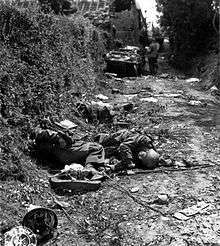2nd Parachute Division (Germany)
The 2nd Parachute Division (2. Fallschirmjäger Division) was an elite airborne division of German Wehrmacht (Luftwaffe) during World War II.
| 2nd Parachute Division | |
|---|---|
 Unit insignia | |
| Active | 1943–45 |
| Country | |
| Branch | |
| Type | Fallschirmjäger |
| Role | Airborne forces |
| Size | Division |
| Engagements | World War II |
| Commanders | |
| Notable commanders | Hermann-Bernhard Ramcke |
Formation
The 2nd Parachute Division was raised in 1943, with the 2nd Parachute Regiment, recently detached from the 1st Parachute Division serving as its nucleus. In May, the division was sent to Avignon in France, where it became part of the XI Flieger Corps along with the 1st Parachute Division. This Corps served as the reserve for the German 10th Army in Italy.
When the Italian government started to crumble in September, the 2nd Parachute Division was dispatched to Italy. It carried out coastal defense duties near the Tiber estuary. The men moved to Rome in the evening of September 8 and participated in a subsequent operation to capture the Italian Army. The 1st Battalion of the 2nd Parachute Regiment participated in the capture of Leros Island in the Dodecanese. The island was then still occupied by Italian forces supplemented by British units following the surrender of Italy. By November 16, the island was retaken by German forces.
Operational history

In October 1943, the division was deployed to the Eastern Front in the Soviet Union and was subordinated to the 42nd Corps, west of Kiev. On December 15, the division was airlifted south toward Kirovograd to contain a Soviet breakout. A German counter-attack then commenced against heavy opposition. By December 23, the attack faltered and the division returned to the defensive. In January 1944, the division remained on the Eastern Front, successfully opposing the Soviet offensive around Kirovograd. The Soviet advance resumed in March causing the division to retreat behind the Bug River. The division fought its last actions on the Eastern Front in May during a counterattack against a Red Army bridgehead across the Dniestr river. At the end of May the weakened division was pulled from the line and returned to Germany for refit, during which time was supplied with more than 1000 FG-42's as part of a new program to equip the paratrooper divisions, although only the 2nd Parachute Division would have the weapon in large numbers. The division was sent to garrison the northern french area.
During the Allied D-Day landings on June 6, 1944, the 6th Regiment was stationed in the Carentan area of the Cotentin Peninsula, near the US 101st Airborne Division's drop zones. The regiment was heavily engaged in the subsequent battles, including at Saint-Lô. On June 13 the remainder of the division was transferred to Brest in western France. In July, the surviving elements of the 6th Regiment were caught in the Falaise Pocket and destroyed during the Allied advance. By August 9 the remainder of the division was driven back and cut off in the city of Brest, where it surrendered on September 20. A new division was formed by December; it fought in the defense of Germany in January 1945 and ended the war in the Ruhr Pocket in April.
War crimes
The division has been implicated in a number of war crimes in Italy[1] between September and October 1943, as follows[2]:
- Rome (16 and 23 September, 7 and 23 October)
- Palidoro (23 September, shooting of Salvo D'Acquisto and 1 October, shooting of 3 civilians)
- Tolfa (10 October, shooting of 12 civilians)
- Mentana (27 October, shooting of 25 civilians and 4 british former POW)
- Bieda di Vetralla (29 October, shooting of 14 civilians)
Commanders
| Date | Commander |
|---|---|
| February 2, 1943 | Generalmajor Hermann-Bernhard Ramcke |
| September 13, 1943 | Generalmajor Walter Barenthin |
| November 14, 1943 | Generalleutnant Gustav Wilke |
| March 17, 1944 | Generalmajor Hans Kroh |
| June 1, 1944 | General Hermann-Bernhard Ramcke |
| August 11, 1944 | Generalmajor Hans Kroh |
| November 15, 1944 | Generalleutnant Walter Lackner |
References
- Citations
- "2. Fallschirm-Jäger-Division" (in Italian). Atlas of Nazi and Fascist Massacres in Italy. Retrieved 20 September 2018.
- See http://194.242.233.149/ortdb/Gentile-ItinerareLazio.pdf, pages 44–46, and
- Works consulted